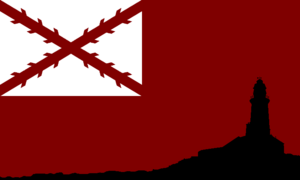Burgoignesc Maritime Navigation Administration
 | |
 | |
| Agency overview | |
|---|---|
| Formed | 30 October 1967 |
| Preceding agencies |
|
| Jurisdiction | Burgundie |
| Headquarters | Port Diteaux, Burgundie |
| Employees | 326 |
| Parent agency | Revenue Guard |
The Autoritat de Navegacion Marin de Burgundie (Eng. Burgoignesc Maritime Navigation Administration), colloquially known as the 'Lighthouse Administration', is the agency of the Government of Burgundie that is the general lighthouse authority for Burgundie. It was responsible for the upkeep and maintenance of all navigational aid in Burgundie. Many of the posidofan (Eng. lighthouses) in Burgundie have been built and maintained by the Revenue Guard (since 1967) and its predecessors, the Viceimperial Burgoignesc Lighthouse Service (1857–1967). Before the Viceimperial Burgoignesc Lighthouse Service was established, local collectors of customs were responsible for lighthouses. As their importance to navigation has declined the Revenue Guard has upgraded many lighthouses to also be GPS and AIS beacons. Burgundie is one of the few nations that still mans lighthouses and maintains the light functionality as part of its maritime navigation service.
Etymology
Posidofan is Burgoignesc word for a lighthouse, stemming from the Istroyan Fanos Posideon meaning Poseidon's lamp. Posidofan denoted the difference from its predecessor the pila pira (Eng. pyre, lit. fire pile) in that is included housing accommodations for a lighthouse keeper. In the 1890s there was an attempt by the Viceimperial Burgoignesc Lighthouse Service to adopt the word cabine della pira (Eng. Lighthouse), but the traditionalists in the maritime services never used the new word and the last recorded publication of cabina della pira was on a nautical chart of Wintergen from 1904.
History

The first maritime navigation "lights" in Burgoignesc history were known as "fotia", the Istroyan word for fire, circa 3000BCE. These pyres were lit near villages when fishermen were not home before dark. This practice remained unchanged until Latinics set up more permanent settlements in Burgundie around the year 500CE. At that time, they introduced more permanent structures called "pila pira" (Eng. fire pile). The first pila pira was built in Port Diteaux in 1084 to facilitate trade with mainland Levantia. The pyre had a stone base 18 meters tall and platform for a massive pyre 12 meters squared. In 1175, a pila pira was built in Vilauristre. This enabled the Bergendii to become early adopters of nocturnal navigation and docking, a technique the doubled the amount of time they could trade, giving them an advantage over other Sea of Istroya and Canete powers.
By 1320, a total of 12 of them located on the Ile of Burgundie. The pyres were never permanent structures and had to be rebuilt after heavy storms. In the 1440s a new technique was introduced that added a layer of permanency to them, turf was added on top of the stones so that the rocks were enveloped and were less likely to become dislodged.
Lighthouses

In the 1530s, the pila pira returned as more permanent stone and wooden structures. This new style of lighthouses also included living quarters and were called "posidofan" meaning Poseidon's lamp in Istroyan. They were not built to any specifications but were often over 10 meters tall, with a semi-covered platform for the fire. What was notable about Burgoignesc posidofan the was the use of parabolic mirrors to intensify the light from the fire. This coupled with the higher fire platform made the Burgoignesc trade ports much easier to find than their mainland counterparts and again made Burgoignesc ports, specifically Vilauristre, the ports of choice for traders from Audonian powers looking to do business with Levantia.
The design remained largely unchanged until the 1780s when whale oil from the Sea of Nordska became available to the Burgoignesc market. At first considered a luxury item, the oil soon flooded the marketplace. Enterprising whale oil importers petitioned princelings to convert the posidofan at Port Diteaux and Vilauristre to the new substance. The smaller storage requirement allowed offshore lighthouses to be resupplied less frequently, the consistency of the burn was notably better than wood fires and the brightness of the flame was considerably better. By 1835 most of the Burgoignesc posidofanhad been converted to whale oil, at great personal expense to the crown. This also led the term "whale oil salesman", a Burgoignesc term meaning: a shrewd, perhaps disingenuous, business persona as the crown was often approached by merchants purporting to be Nordskan oil merchants and selling them fish oil or other substances.
In Faneria
In 1604, Rih Donan Suthar-Màrtainn contracted Burgoignesc naval officers to form the Royal Foreign Naval Training Association, a precursor to the Burgundine-Fhainnin Naval Academy, Simultaneously, he set aside funds for a program of lighthouses along parts of the Kilikas coast, contracting the BMNA for maintenance, advisement, and in some cases manning of these outposts. Similar deals were arranged with principalities along the coast that would later be incorporated into Faneria, and the Kingdom maintained these contracts with Burgundie.
After the Fhainnin Civil War, the lighthouses in Faneria were nationalized by the government; however, in 1954, control of a number of them was returned to the Burgoignesc Lighthouse Administration as part of a new commercial contract.
Gallery of Modern Lighthouses
-
Vilauristre light
-
Alcairet lighthouse
-
Alcairet lighthouse
-
Nauta Normand lighthouse
-
Alcairet lighthouse
-
Torlen lighthouse
-
Torlen lighthouse
-
Torlen lighthouse
-
Torlen lighthouse
-
Torlen lighthouse
-
Torlen lighthouse
-
Iparnor Head Lighthouse
Special Cases
Some lighthouses, especially those overseas are purported to be hubs of Burgoignesc intelligence gathering.
26 lighthouses across the Burgoignesc Thalattocracy are owned and maintained by non-governmental organizations, 11 by the Seager Corporation, 6 by O’Shea Container Shipping, 4 by the Lighthouse Preservation Corps, 3 by Doppel Gangway and 2 by Beacon Business Continuity and Incident Management.











